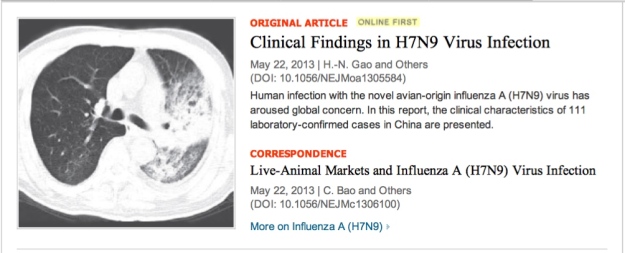27% of patients with H7N9 Influenza A died. This is the finding of a report just released in the New England Journal of Medicine is a study of 111 of the 132 confirmed cases of H7N9 Influenza A*.
Acute Kidney Injury or “Kidney Attack” was amongst the most common complications.
Of the 111 patients we evaluated, 85 (76.6%) were admitted to an intensive care unit (ICU); of these patients, 54 were directly admitted to the ICU, and 31 were admitted during hospitalization. Moderate-to-severe ARDS [Acute Respiratory Disease Syndrome] was the most common complication (in 79 patients), followed by shock (in 29 patients), acute kidney injury (in 18 patients), and rhabdomyolysis (in 11 patients).
In an analysis in the Appendix to the paper a comparison was made between the 30 patients who had died and 49 who had recovered (others were still in hospital). 100% of those who died had had ARDS compared with 40% of those who recovered. One third of those who died had Acute Kidney Injury compared with 4% of those who recovered. From a statistical perspective these numbers illustrate a real difference with a low probability (~ 1-2 out of 1000) of observing such a difference by chance.**
Note, all patients had been in close contact withe live chickens or pigeons within 2 weeks of hospitalisaton.
* Clinical Findings in 111 Cases of Influenza A (H7N9) Virus Infection
Hai-Nv Gao, M.D., Hong-Zhou Lu, M.D., Ph.D., Bin Cao, M.D., Bin Du, M.D., Hong Shang, M.D., Jian-He Gan, M.D., Shui-Hua Lu, M.D., Yi-Da Yang, M.D., Qiang Fang, M.D., Yin-Zhong Shen, M.D., Xiu-Ming Xi, M.D., Qin Gu, M.D., Xian-Mei Zhou, M.D., Hong-Ping Qu, M.D., Zheng Yan, M.D., Fang-Ming Li, M.D., Wei Zhao, M.D., Zhan-Cheng Gao, M.D., Guang-Fa Wang, M.D., Ling-Xiang Ruan, M.D., Wei-Hong Wang, M.D., Jun Ye, M.D., Hui-Fang Cao, M.D., Xing-Wang Li, M.D., Wen-Hong Zhang, M.D., Xu-Chen Fang, M.D., Jian He, M.D., Wei-Feng Liang, M.D., Juan Xie, M.D., Mei Zeng, M.D., Xian-Zheng Wu, M.D., Jun Li, M.D., Qi Xia, M.D., Zhao-Chen Jin, M.D., Qi Chen, M.D., Chao Tang, M.D., Zhi-Yong Zhang, M.D., Bao-Min Hou, M.D., Zhi-Xian Feng, M.D., Ji-Fang Sheng, M.D., Nan-Shan Zhong, M.D., and Lan-Juan Li, M.D.New England Journal of Medicine Online May 22, 2013 DOI: 10.1056/NEJMoa1305584
** something called a multivariate analysis was attempted which trys to take into account correlations between diseases to see which diseases are the major factors. However, with “only” 30 deaths such an analysis is very limited and I do not think of value in this situation.
